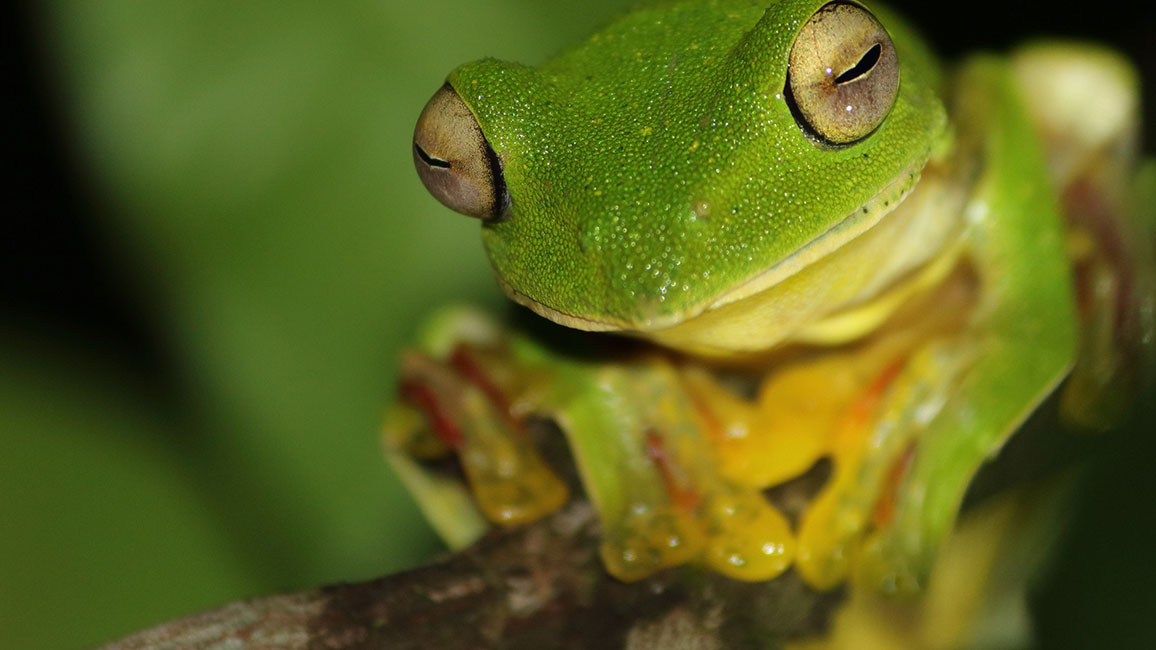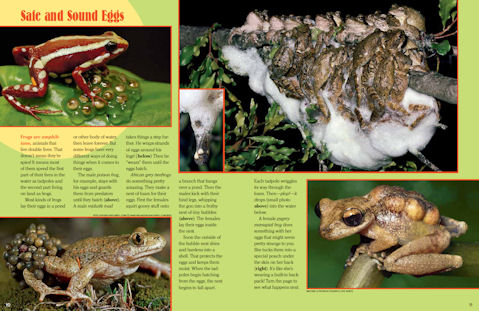
Frogs
By Kathy KrankingFrogs do some things that might seem strange to you. But that’s just because you’re not a frog! For frogs, these things are perfectly normal ways of surviving.
There are almost 6,000 species of frogs, and they live all around the world except in Antarctica. Some kinds are smaller than lima beans while others are almost as big as footballs.
Frogs’ bodies are pretty different from yours. Take their legs, for example. They’re packed with muscles that make some frogs amazing jumpers.
One of the farthest-jumping frogs is the Australian rocket frog. It can leap about 50 times its own body length. That’s like you being able to jump most of the way across a football field in a single bound! Frogs are amazing in lots of other ways, too. For one thing, they are incredible hunters. A frog’s tongue is attached at the front of the mouth instead of at the back, as yours is. The tongue is covered in sticky stuff. To catch a meal, the frog flips its tongue out (photo 1) nabs the prey, then gobbles it up—all in less than a second! As the frog swallows, its eyeballs sink down into its head. That helps to push the food down its throat (photo 2). Frogs have lungs, but they can also take in oxygen through their skin. So when they’re underwater, they don’t have to come up to breathe.
Some frogs have webbed feet to help with swimming. And sticky toe pads give treefrogs a non-slip grip on branches and leaves.
DRESSED FOR SUCCESS
Here’s another thing that sounds freaky about frogs: Many kinds can make themselves disappear! It’s not really so freaky, though. They do it with camouflage!
Some frogs blend in by matching the colors around them. This can make them invisible to predators as well as prey. But some go even further. They match the color and shape of their surroundings.
Can you figure out how many of the “leaves” in the photo above left are actually leaf mimic toads? (Toads are a kind of frog.)
Poison frogs, on the other hand, don’t “dress” to blend in—they dress to stand out. The strawberry poison frog at top left is more than just pretty. Its colors are a warning to predators to steer clear because the frog is poisonous.
A CHORUS OF CALLERS
Do you like to blow bubbles? So do male frogs! But they don’t use chewing gum. They have built-in bubbles! That might sound like another freaky thing, but it’s actually a great way to help the frogs find mates.
Here’s why: When springtime comes, male frogs gather at ponds and sing to invite female frogs to mate with them. They also sing to tell other males to stay away from their part of the pond. Each kind of frog has its own song. When the males sing, they inflate their vocal sacs, making them look like big bubbles. This helps make their voices sound louder.
Check out the gladiator treefrog at top right. It has a “bubble chin.” And the edible frog above right is blowing double bubbles!
SAFE AND SOUND EGGS
Frogs are amphibians, animals that live double lives. That doesn’t mean they’re spies! It means most of them spend the first part of their lives in the water as tadpoles and the second part living on land as frogs.
Most kinds of frogs lay their eggs in a pond or other body of water, then leave forever. But some frogs have very different ways of doing things when it comes to their eggs.
The male poison frog, for example, stays with his eggs and guards them from predators until they hatch (top left). A male midwife toad takes things a step further. He wraps strands of eggs around his legs! (above left) Then he “wears” them until the eggs hatch.
African grey treefrogs do something pretty amazing. They make a nest of foam for their eggs. First the females squirt gooey stuff onto a branch that hangs over a pond. Then the males kick with their hind legs, whipping the goo into a frothy nest of tiny bubbles (top right). The females lay their eggs inside the nest. Soon the outside of the bubble nest dries and hardens into a shell. That protects the eggs and keeps them moist. When the tadpoles begin hatching from the eggs, the nest begins to fall apart. Each tadpole wriggles its way through the foam. Then—plop!—it drops (small photo above) into the water below. A female pygmy marsupial frog does something with her eggs that might seem pretty strange to you. She tucks them into a special pouch under the skin on her back (above right). It’s like she’s wearing a built-in backpack!
RickBYE-BYE, BABIES
When it’s time for a pygmy marsupial frog’s babies to hatch, the female finds a plant called a bromeliad (bro-MEE-lee-ad). Rainwater often collects in the center of a bromeliad’s leaves, making a pool. The mom backs into the pool, and the tadpoles wriggle out of the pouch and into their new “swimming pool” home (top photo).
When the strawberry poison frog’s eggs hatch, the mom moves the tadpoles to a bromeliad pool, as well. One by one, each tadpole gets a “froggyback” ride! (bottom photo) The Darwin’s frog does something that might seem the freakiest of all to you. When the eggs are almost ready to hatch, the dad gobbles them up! They land inside his vocal sac, where they hatch into tadpoles and grow into frogs. Then they hop out of their dad’s mouth, ready to go!
So now you know the truth: Though they’re totally amazing and often surprising, there’s really nothing freaky about frogs!
“Frogs” originally appeared in the April 2011 issue of Ranger Rick magazine.
(Click on each image above for a closer view of the story.)




















